Analysis of HRM Practices at Tesco PLC: Talent, Skills, and Objectives
VerifiedAdded on 2024/05/21
|26
|6498
|496
Report
AI Summary
This report provides a comprehensive analysis of Human Resource Management (HRM) practices at Tesco PLC, a multinational grocery and general merchandise retailer. It explains the purpose and scope of HRM in resourcing talent and skills to fulfill business objectives, evaluates the effectiveness of key HRM elements within the organization, and analyzes internal and external factors, including employment legislation, that influence HRM decision-making. The report also applies HRM practices in a work-related context, examining different approaches to recruitment and selection, including internal and external methods, and discusses their respective strengths and weaknesses. It further explores the 'Best Fit Model' and 'Best Practice Approach' in relation to Tesco's HRM strategies, differentiating between Hard and Soft HRM models and their application within the company's democratic leadership style. The report concludes by highlighting the importance of effective HRM policies in managing Tesco's vast and culturally diverse workforce across its global operations.
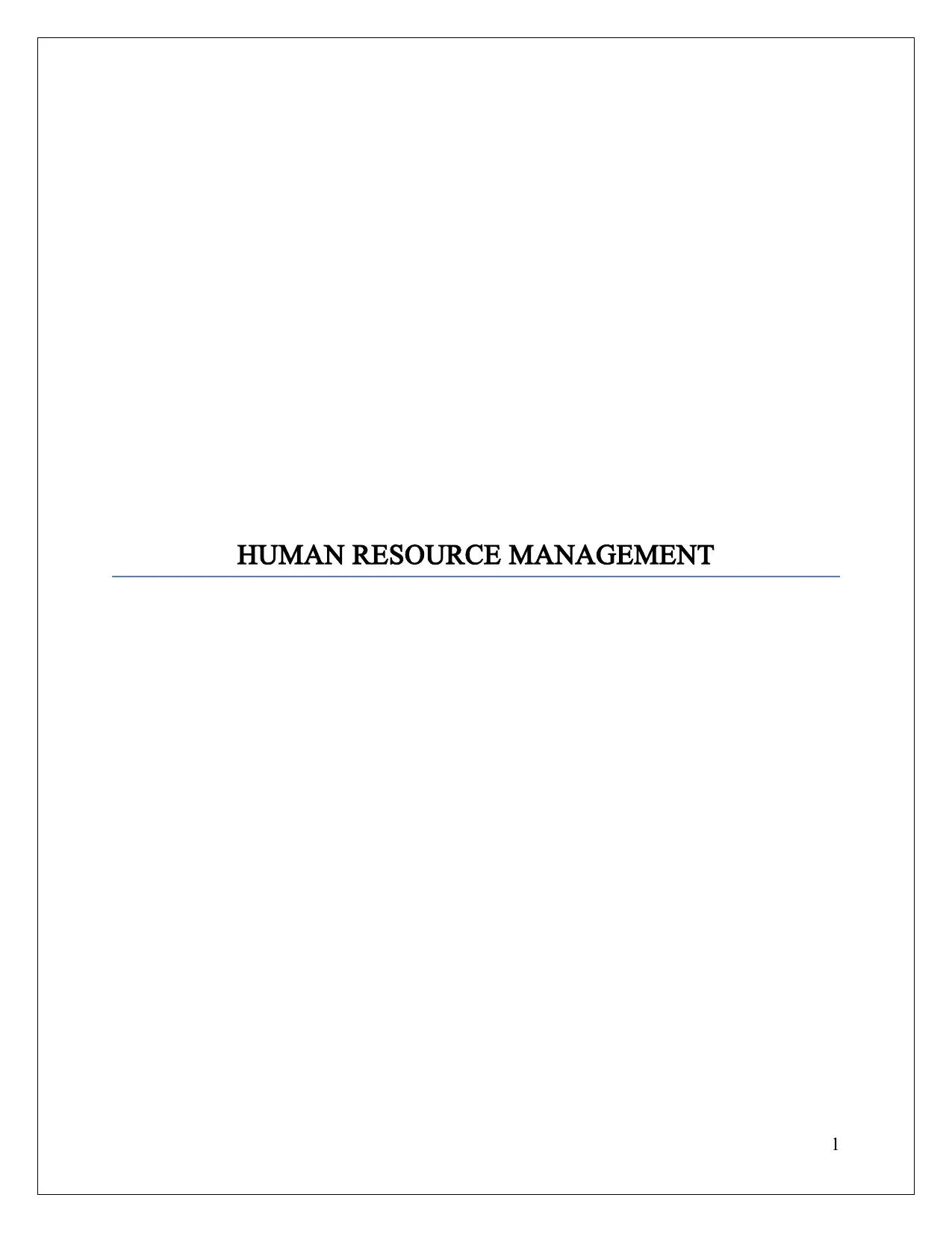
HUMAN RESOURCE MANAGEMENT
1
1
Paraphrase This Document
Need a fresh take? Get an instant paraphrase of this document with our AI Paraphraser
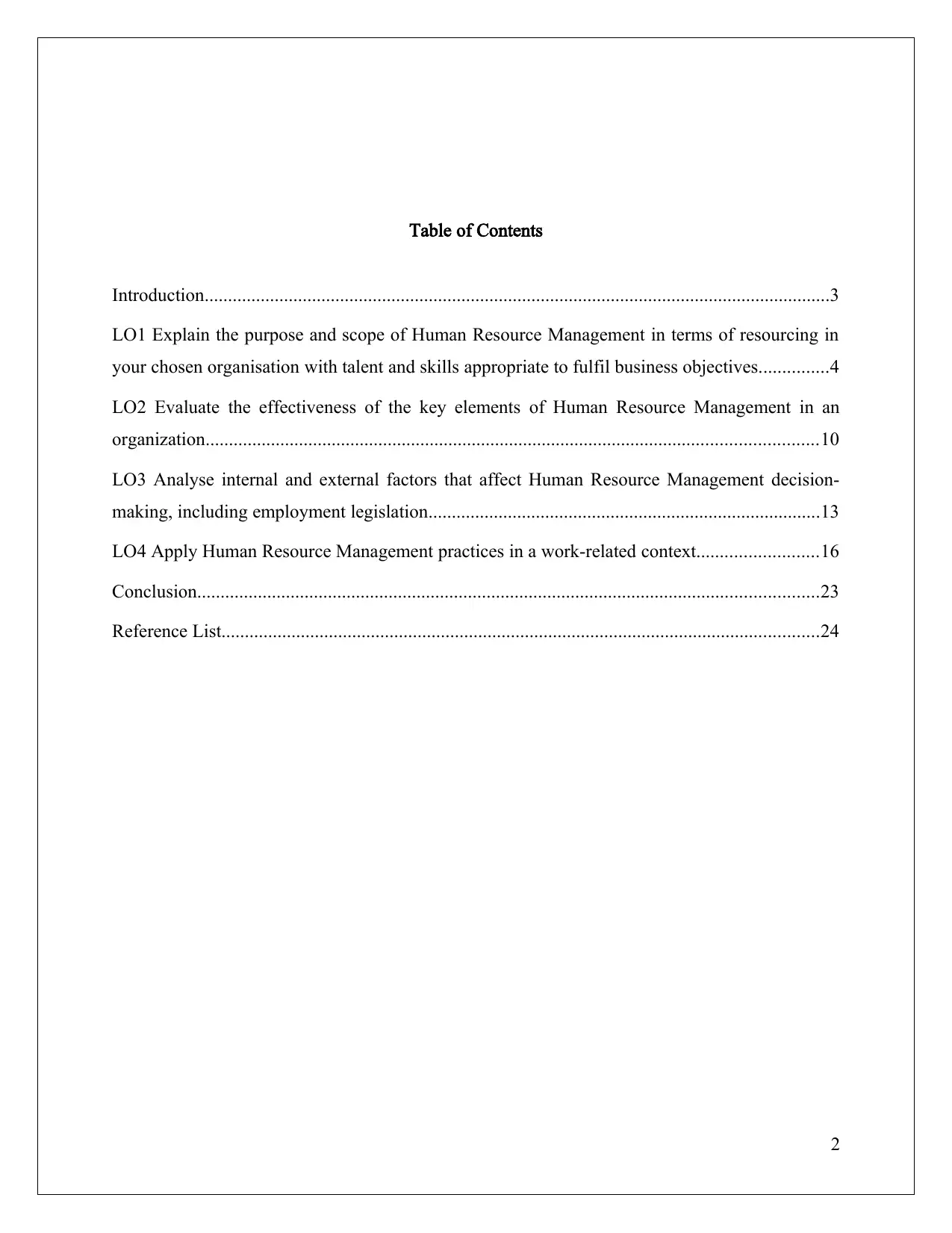
Table of Contents
Introduction......................................................................................................................................3
LO1 Explain the purpose and scope of Human Resource Management in terms of resourcing in
your chosen organisation with talent and skills appropriate to fulfil business objectives...............4
LO2 Evaluate the effectiveness of the key elements of Human Resource Management in an
organization...................................................................................................................................10
LO3 Analyse internal and external factors that affect Human Resource Management decision-
making, including employment legislation....................................................................................13
LO4 Apply Human Resource Management practices in a work-related context..........................16
Conclusion.....................................................................................................................................23
Reference List................................................................................................................................24
2
Introduction......................................................................................................................................3
LO1 Explain the purpose and scope of Human Resource Management in terms of resourcing in
your chosen organisation with talent and skills appropriate to fulfil business objectives...............4
LO2 Evaluate the effectiveness of the key elements of Human Resource Management in an
organization...................................................................................................................................10
LO3 Analyse internal and external factors that affect Human Resource Management decision-
making, including employment legislation....................................................................................13
LO4 Apply Human Resource Management practices in a work-related context..........................16
Conclusion.....................................................................................................................................23
Reference List................................................................................................................................24
2
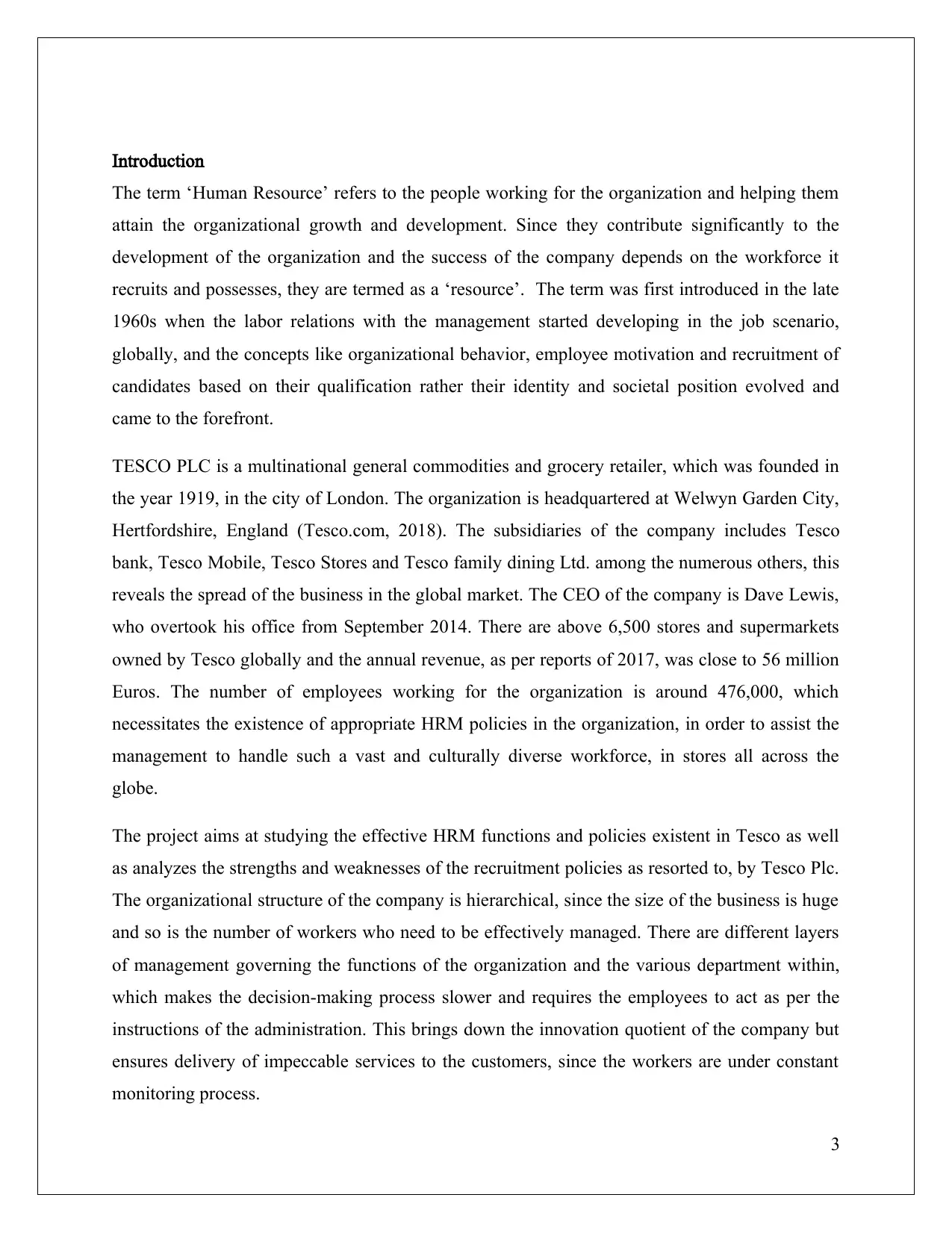
Introduction
The term ‘Human Resource’ refers to the people working for the organization and helping them
attain the organizational growth and development. Since they contribute significantly to the
development of the organization and the success of the company depends on the workforce it
recruits and possesses, they are termed as a ‘resource’. The term was first introduced in the late
1960s when the labor relations with the management started developing in the job scenario,
globally, and the concepts like organizational behavior, employee motivation and recruitment of
candidates based on their qualification rather their identity and societal position evolved and
came to the forefront.
TESCO PLC is a multinational general commodities and grocery retailer, which was founded in
the year 1919, in the city of London. The organization is headquartered at Welwyn Garden City,
Hertfordshire, England (Tesco.com, 2018). The subsidiaries of the company includes Tesco
bank, Tesco Mobile, Tesco Stores and Tesco family dining Ltd. among the numerous others, this
reveals the spread of the business in the global market. The CEO of the company is Dave Lewis,
who overtook his office from September 2014. There are above 6,500 stores and supermarkets
owned by Tesco globally and the annual revenue, as per reports of 2017, was close to 56 million
Euros. The number of employees working for the organization is around 476,000, which
necessitates the existence of appropriate HRM policies in the organization, in order to assist the
management to handle such a vast and culturally diverse workforce, in stores all across the
globe.
The project aims at studying the effective HRM functions and policies existent in Tesco as well
as analyzes the strengths and weaknesses of the recruitment policies as resorted to, by Tesco Plc.
The organizational structure of the company is hierarchical, since the size of the business is huge
and so is the number of workers who need to be effectively managed. There are different layers
of management governing the functions of the organization and the various department within,
which makes the decision-making process slower and requires the employees to act as per the
instructions of the administration. This brings down the innovation quotient of the company but
ensures delivery of impeccable services to the customers, since the workers are under constant
monitoring process.
3
The term ‘Human Resource’ refers to the people working for the organization and helping them
attain the organizational growth and development. Since they contribute significantly to the
development of the organization and the success of the company depends on the workforce it
recruits and possesses, they are termed as a ‘resource’. The term was first introduced in the late
1960s when the labor relations with the management started developing in the job scenario,
globally, and the concepts like organizational behavior, employee motivation and recruitment of
candidates based on their qualification rather their identity and societal position evolved and
came to the forefront.
TESCO PLC is a multinational general commodities and grocery retailer, which was founded in
the year 1919, in the city of London. The organization is headquartered at Welwyn Garden City,
Hertfordshire, England (Tesco.com, 2018). The subsidiaries of the company includes Tesco
bank, Tesco Mobile, Tesco Stores and Tesco family dining Ltd. among the numerous others, this
reveals the spread of the business in the global market. The CEO of the company is Dave Lewis,
who overtook his office from September 2014. There are above 6,500 stores and supermarkets
owned by Tesco globally and the annual revenue, as per reports of 2017, was close to 56 million
Euros. The number of employees working for the organization is around 476,000, which
necessitates the existence of appropriate HRM policies in the organization, in order to assist the
management to handle such a vast and culturally diverse workforce, in stores all across the
globe.
The project aims at studying the effective HRM functions and policies existent in Tesco as well
as analyzes the strengths and weaknesses of the recruitment policies as resorted to, by Tesco Plc.
The organizational structure of the company is hierarchical, since the size of the business is huge
and so is the number of workers who need to be effectively managed. There are different layers
of management governing the functions of the organization and the various department within,
which makes the decision-making process slower and requires the employees to act as per the
instructions of the administration. This brings down the innovation quotient of the company but
ensures delivery of impeccable services to the customers, since the workers are under constant
monitoring process.
3
⊘ This is a preview!⊘
Do you want full access?
Subscribe today to unlock all pages.

Trusted by 1+ million students worldwide
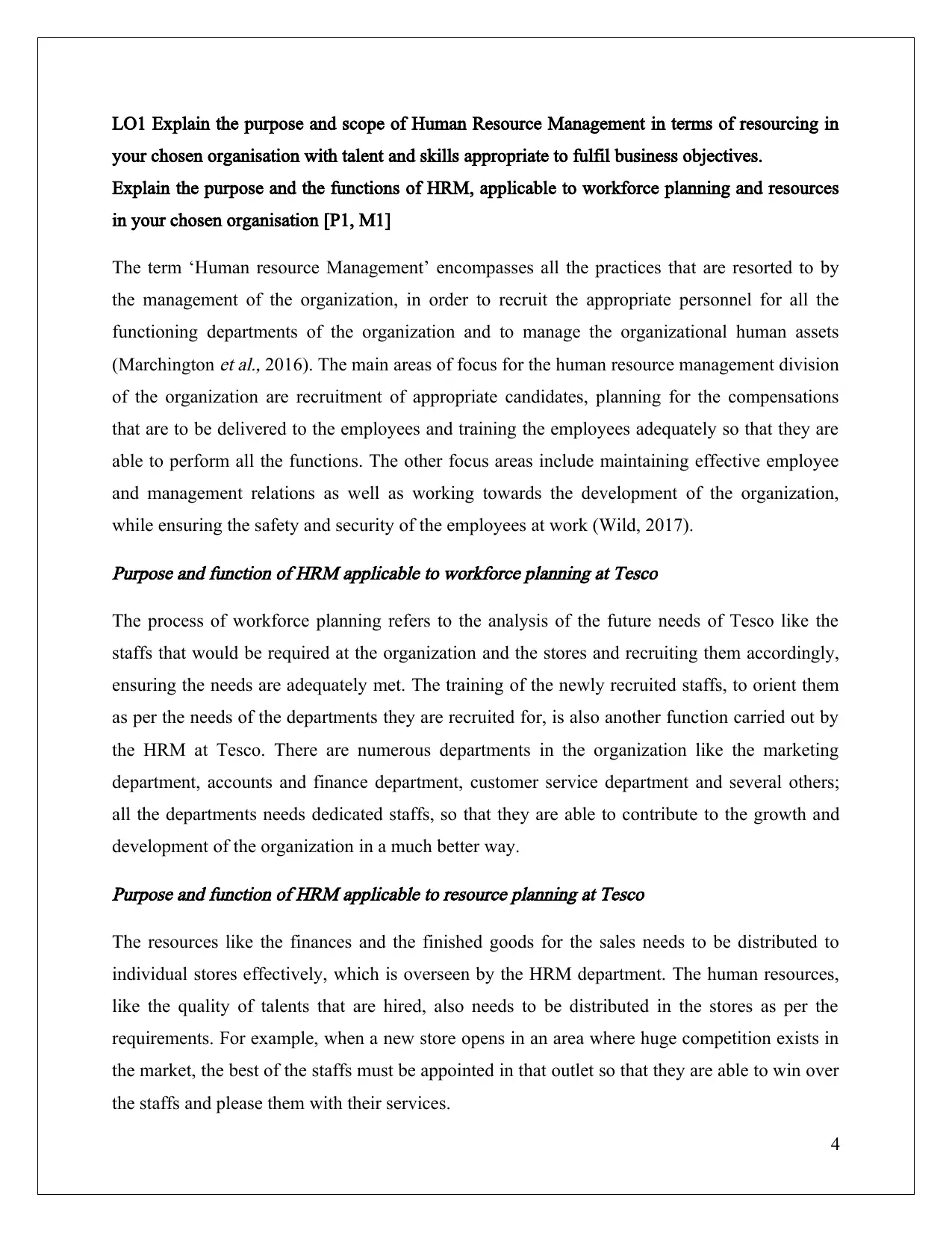
LO1 Explain the purpose and scope of Human Resource Management in terms of resourcing in
your chosen organisation with talent and skills appropriate to fulfil business objectives.
Explain the purpose and the functions of HRM, applicable to workforce planning and resources
in your chosen organisation [P1, M1]
The term ‘Human resource Management’ encompasses all the practices that are resorted to by
the management of the organization, in order to recruit the appropriate personnel for all the
functioning departments of the organization and to manage the organizational human assets
(Marchington
et al., 2016). The main areas of focus for the human resource management division
of the organization are recruitment of appropriate candidates, planning for the compensations
that are to be delivered to the employees and training the employees adequately so that they are
able to perform all the functions. The other focus areas include maintaining effective employee
and management relations as well as working towards the development of the organization,
while ensuring the safety and security of the employees at work (Wild, 2017).
Purpose and function of HRM applicable to workforce planning at Tesco
The process of workforce planning refers to the analysis of the future needs of Tesco like the
staffs that would be required at the organization and the stores and recruiting them accordingly,
ensuring the needs are adequately met. The training of the newly recruited staffs, to orient them
as per the needs of the departments they are recruited for, is also another function carried out by
the HRM at Tesco. There are numerous departments in the organization like the marketing
department, accounts and finance department, customer service department and several others;
all the departments needs dedicated staffs, so that they are able to contribute to the growth and
development of the organization in a much better way.
Purpose and function of HRM applicable to resource planning at Tesco
The resources like the finances and the finished goods for the sales needs to be distributed to
individual stores effectively, which is overseen by the HRM department. The human resources,
like the quality of talents that are hired, also needs to be distributed in the stores as per the
requirements. For example, when a new store opens in an area where huge competition exists in
the market, the best of the staffs must be appointed in that outlet so that they are able to win over
the staffs and please them with their services.
4
your chosen organisation with talent and skills appropriate to fulfil business objectives.
Explain the purpose and the functions of HRM, applicable to workforce planning and resources
in your chosen organisation [P1, M1]
The term ‘Human resource Management’ encompasses all the practices that are resorted to by
the management of the organization, in order to recruit the appropriate personnel for all the
functioning departments of the organization and to manage the organizational human assets
(Marchington
et al., 2016). The main areas of focus for the human resource management division
of the organization are recruitment of appropriate candidates, planning for the compensations
that are to be delivered to the employees and training the employees adequately so that they are
able to perform all the functions. The other focus areas include maintaining effective employee
and management relations as well as working towards the development of the organization,
while ensuring the safety and security of the employees at work (Wild, 2017).
Purpose and function of HRM applicable to workforce planning at Tesco
The process of workforce planning refers to the analysis of the future needs of Tesco like the
staffs that would be required at the organization and the stores and recruiting them accordingly,
ensuring the needs are adequately met. The training of the newly recruited staffs, to orient them
as per the needs of the departments they are recruited for, is also another function carried out by
the HRM at Tesco. There are numerous departments in the organization like the marketing
department, accounts and finance department, customer service department and several others;
all the departments needs dedicated staffs, so that they are able to contribute to the growth and
development of the organization in a much better way.
Purpose and function of HRM applicable to resource planning at Tesco
The resources like the finances and the finished goods for the sales needs to be distributed to
individual stores effectively, which is overseen by the HRM department. The human resources,
like the quality of talents that are hired, also needs to be distributed in the stores as per the
requirements. For example, when a new store opens in an area where huge competition exists in
the market, the best of the staffs must be appointed in that outlet so that they are able to win over
the staffs and please them with their services.
4
Paraphrase This Document
Need a fresh take? Get an instant paraphrase of this document with our AI Paraphraser
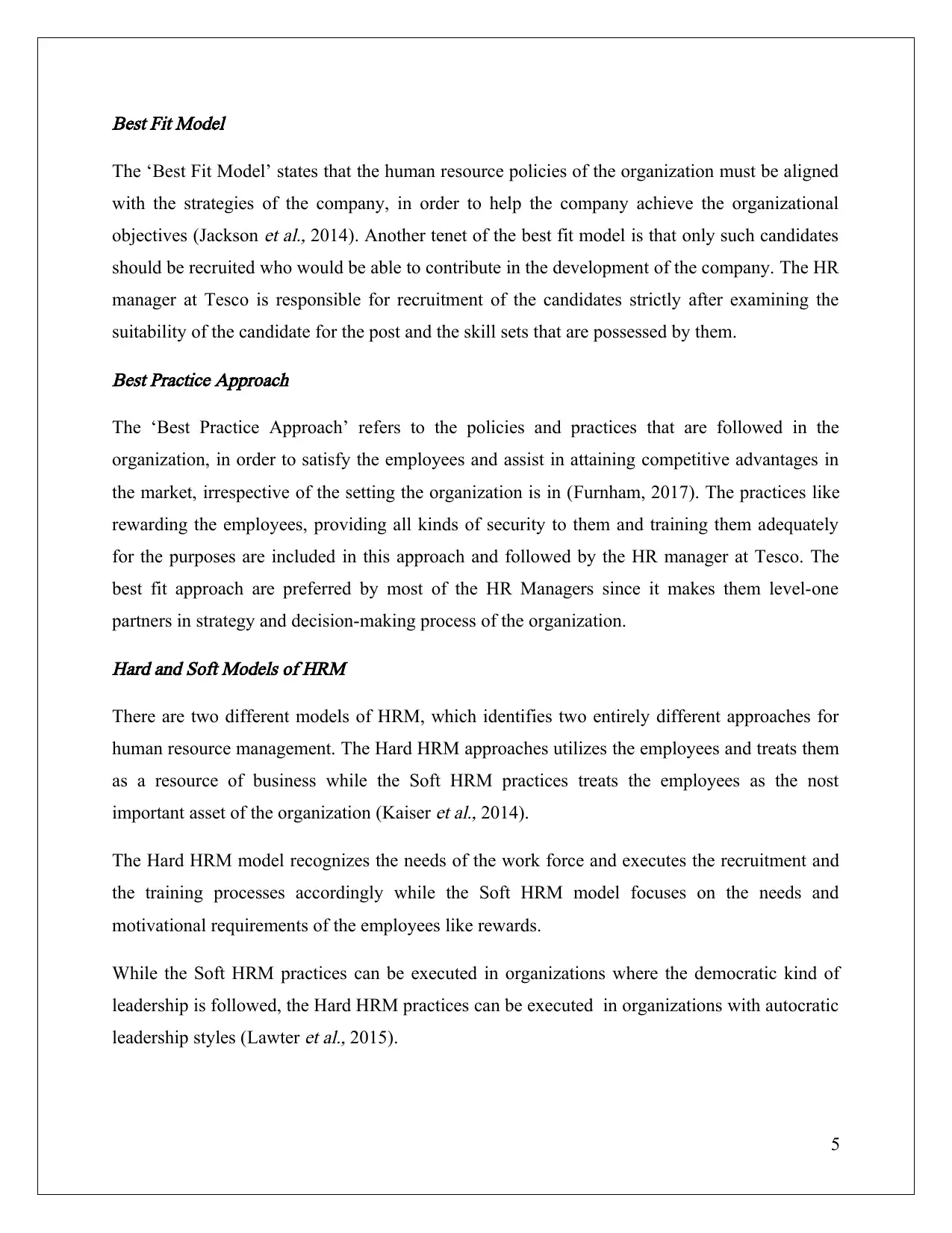
Best Fit Model
The ‘Best Fit Model’ states that the human resource policies of the organization must be aligned
with the strategies of the company, in order to help the company achieve the organizational
objectives (Jackson
et al., 2014). Another tenet of the best fit model is that only such candidates
should be recruited who would be able to contribute in the development of the company. The HR
manager at Tesco is responsible for recruitment of the candidates strictly after examining the
suitability of the candidate for the post and the skill sets that are possessed by them.
Best Practice Approach
The ‘Best Practice Approach’ refers to the policies and practices that are followed in the
organization, in order to satisfy the employees and assist in attaining competitive advantages in
the market, irrespective of the setting the organization is in (Furnham, 2017). The practices like
rewarding the employees, providing all kinds of security to them and training them adequately
for the purposes are included in this approach and followed by the HR manager at Tesco. The
best fit approach are preferred by most of the HR Managers since it makes them level-one
partners in strategy and decision-making process of the organization.
Hard and Soft Models of HRM
There are two different models of HRM, which identifies two entirely different approaches for
human resource management. The Hard HRM approaches utilizes the employees and treats them
as a resource of business while the Soft HRM practices treats the employees as the nost
important asset of the organization (Kaiser
et al., 2014).
The Hard HRM model recognizes the needs of the work force and executes the recruitment and
the training processes accordingly while the Soft HRM model focuses on the needs and
motivational requirements of the employees like rewards.
While the Soft HRM practices can be executed in organizations where the democratic kind of
leadership is followed, the Hard HRM practices can be executed in organizations with autocratic
leadership styles (Lawter
et al., 2015).
5
The ‘Best Fit Model’ states that the human resource policies of the organization must be aligned
with the strategies of the company, in order to help the company achieve the organizational
objectives (Jackson
et al., 2014). Another tenet of the best fit model is that only such candidates
should be recruited who would be able to contribute in the development of the company. The HR
manager at Tesco is responsible for recruitment of the candidates strictly after examining the
suitability of the candidate for the post and the skill sets that are possessed by them.
Best Practice Approach
The ‘Best Practice Approach’ refers to the policies and practices that are followed in the
organization, in order to satisfy the employees and assist in attaining competitive advantages in
the market, irrespective of the setting the organization is in (Furnham, 2017). The practices like
rewarding the employees, providing all kinds of security to them and training them adequately
for the purposes are included in this approach and followed by the HR manager at Tesco. The
best fit approach are preferred by most of the HR Managers since it makes them level-one
partners in strategy and decision-making process of the organization.
Hard and Soft Models of HRM
There are two different models of HRM, which identifies two entirely different approaches for
human resource management. The Hard HRM approaches utilizes the employees and treats them
as a resource of business while the Soft HRM practices treats the employees as the nost
important asset of the organization (Kaiser
et al., 2014).
The Hard HRM model recognizes the needs of the work force and executes the recruitment and
the training processes accordingly while the Soft HRM model focuses on the needs and
motivational requirements of the employees like rewards.
While the Soft HRM practices can be executed in organizations where the democratic kind of
leadership is followed, the Hard HRM practices can be executed in organizations with autocratic
leadership styles (Lawter
et al., 2015).
5
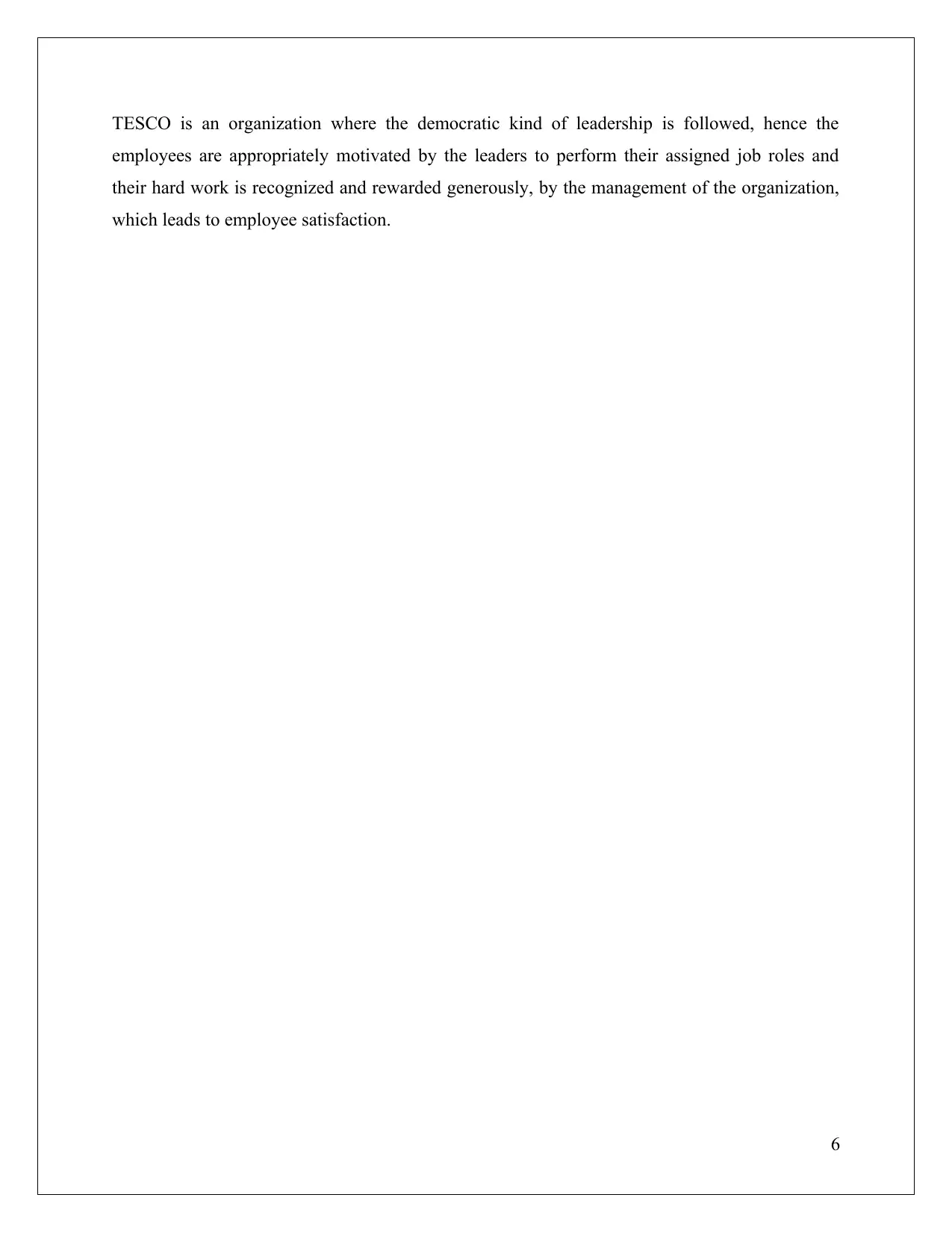
TESCO is an organization where the democratic kind of leadership is followed, hence the
employees are appropriately motivated by the leaders to perform their assigned job roles and
their hard work is recognized and rewarded generously, by the management of the organization,
which leads to employee satisfaction.
6
employees are appropriately motivated by the leaders to perform their assigned job roles and
their hard work is recognized and rewarded generously, by the management of the organization,
which leads to employee satisfaction.
6
⊘ This is a preview!⊘
Do you want full access?
Subscribe today to unlock all pages.

Trusted by 1+ million students worldwide
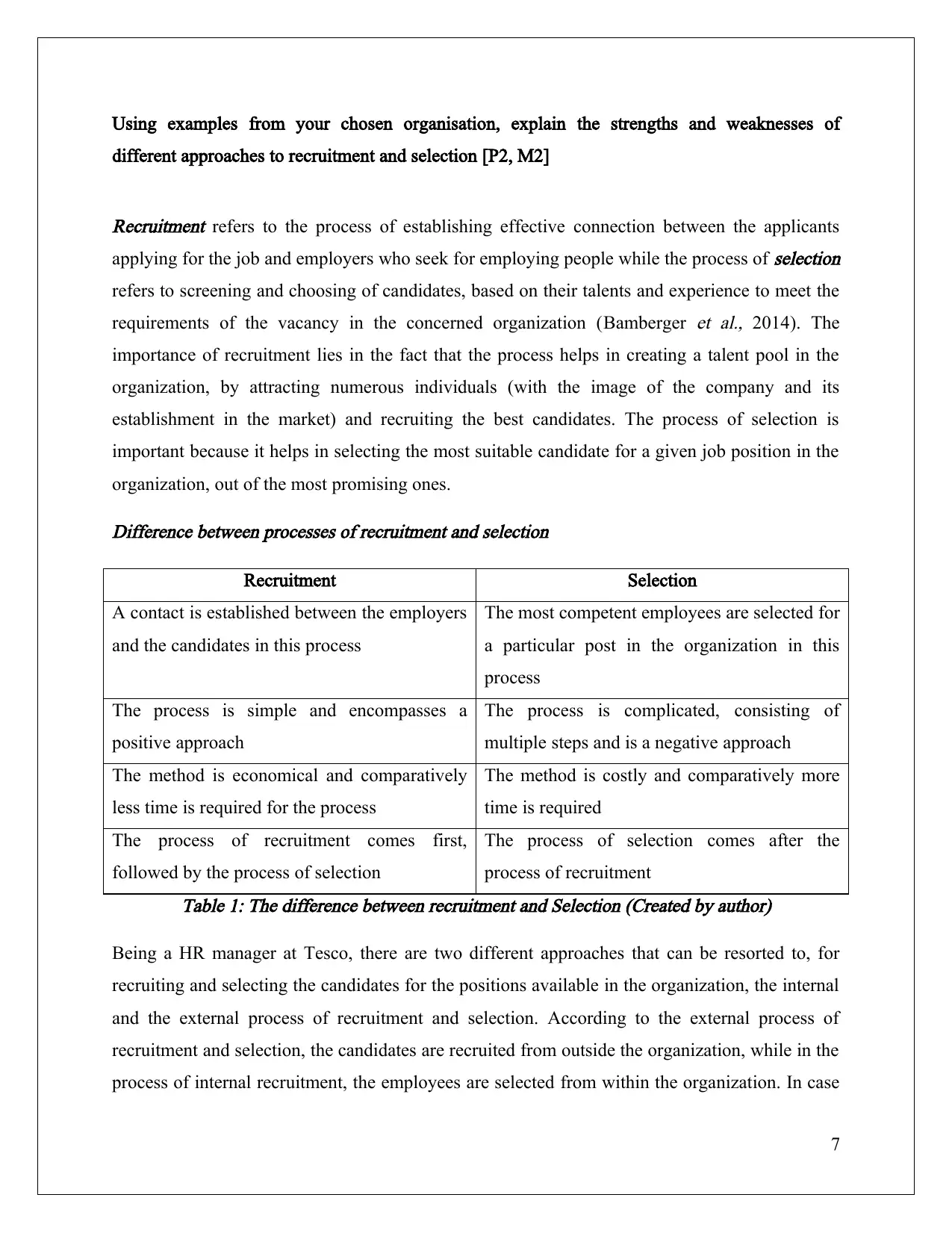
Using examples from your chosen organisation, explain the strengths and weaknesses of
different approaches to recruitment and selection [P2, M2]
Recruitment refers to the process of establishing effective connection between the applicants
applying for the job and employers who seek for employing people while the process of
selection
refers to screening and choosing of candidates, based on their talents and experience to meet the
requirements of the vacancy in the concerned organization (Bamberger
et al., 2014). The
importance of recruitment lies in the fact that the process helps in creating a talent pool in the
organization, by attracting numerous individuals (with the image of the company and its
establishment in the market) and recruiting the best candidates. The process of selection is
important because it helps in selecting the most suitable candidate for a given job position in the
organization, out of the most promising ones.
Difference between processes of recruitment and selection
Recruitment Selection
A contact is established between the employers
and the candidates in this process
The most competent employees are selected for
a particular post in the organization in this
process
The process is simple and encompasses a
positive approach
The process is complicated, consisting of
multiple steps and is a negative approach
The method is economical and comparatively
less time is required for the process
The method is costly and comparatively more
time is required
The process of recruitment comes first,
followed by the process of selection
The process of selection comes after the
process of recruitment
Table 1: The difference between recruitment and Selection (Created by author)
Being a HR manager at Tesco, there are two different approaches that can be resorted to, for
recruiting and selecting the candidates for the positions available in the organization, the internal
and the external process of recruitment and selection. According to the external process of
recruitment and selection, the candidates are recruited from outside the organization, while in the
process of internal recruitment, the employees are selected from within the organization. In case
7
different approaches to recruitment and selection [P2, M2]
Recruitment refers to the process of establishing effective connection between the applicants
applying for the job and employers who seek for employing people while the process of
selection
refers to screening and choosing of candidates, based on their talents and experience to meet the
requirements of the vacancy in the concerned organization (Bamberger
et al., 2014). The
importance of recruitment lies in the fact that the process helps in creating a talent pool in the
organization, by attracting numerous individuals (with the image of the company and its
establishment in the market) and recruiting the best candidates. The process of selection is
important because it helps in selecting the most suitable candidate for a given job position in the
organization, out of the most promising ones.
Difference between processes of recruitment and selection
Recruitment Selection
A contact is established between the employers
and the candidates in this process
The most competent employees are selected for
a particular post in the organization in this
process
The process is simple and encompasses a
positive approach
The process is complicated, consisting of
multiple steps and is a negative approach
The method is economical and comparatively
less time is required for the process
The method is costly and comparatively more
time is required
The process of recruitment comes first,
followed by the process of selection
The process of selection comes after the
process of recruitment
Table 1: The difference between recruitment and Selection (Created by author)
Being a HR manager at Tesco, there are two different approaches that can be resorted to, for
recruiting and selecting the candidates for the positions available in the organization, the internal
and the external process of recruitment and selection. According to the external process of
recruitment and selection, the candidates are recruited from outside the organization, while in the
process of internal recruitment, the employees are selected from within the organization. In case
7
Paraphrase This Document
Need a fresh take? Get an instant paraphrase of this document with our AI Paraphraser
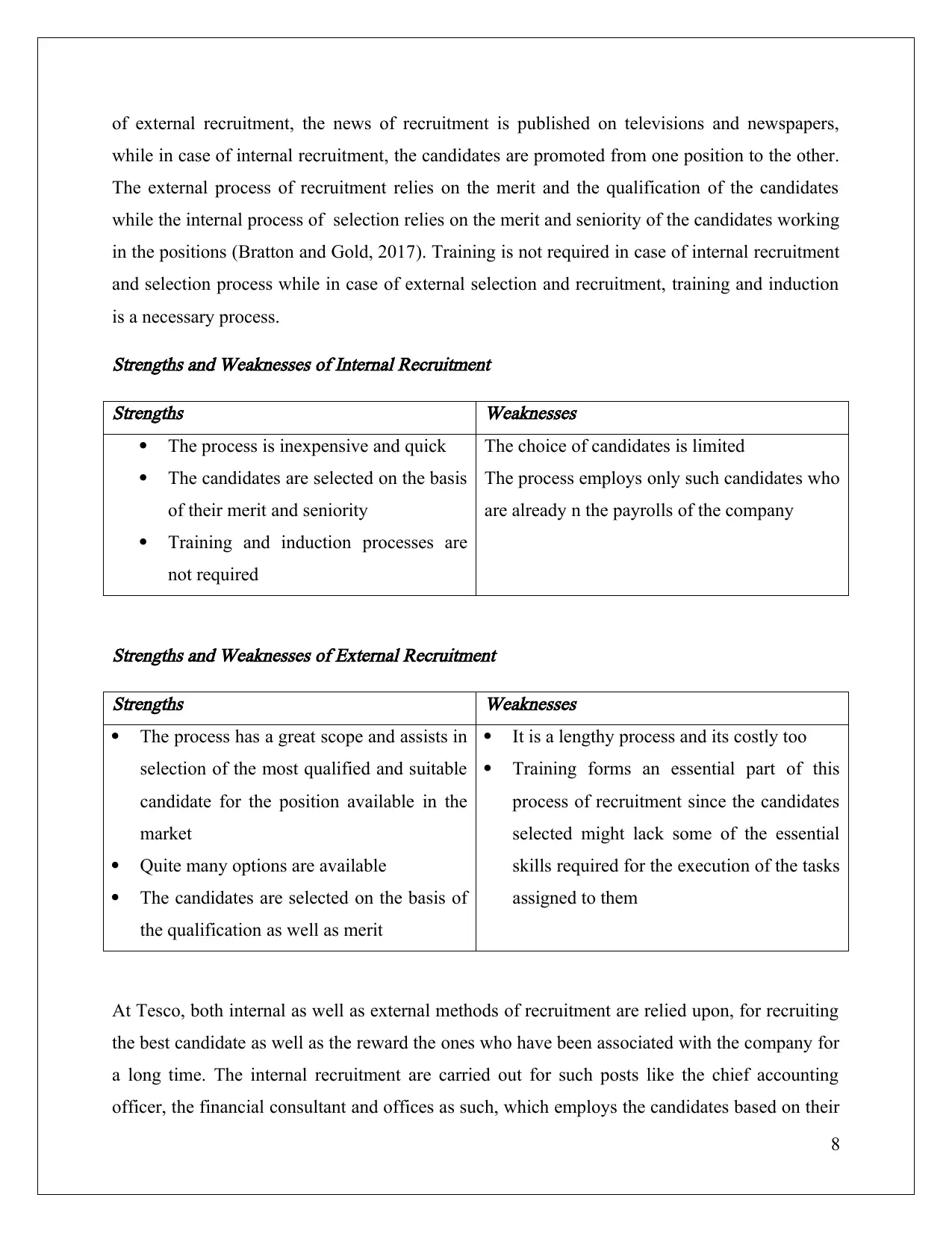
of external recruitment, the news of recruitment is published on televisions and newspapers,
while in case of internal recruitment, the candidates are promoted from one position to the other.
The external process of recruitment relies on the merit and the qualification of the candidates
while the internal process of selection relies on the merit and seniority of the candidates working
in the positions (Bratton and Gold, 2017). Training is not required in case of internal recruitment
and selection process while in case of external selection and recruitment, training and induction
is a necessary process.
Strengths and Weaknesses of Internal Recruitment
Strengths
Weaknesses
The process is inexpensive and quick
The candidates are selected on the basis
of their merit and seniority
Training and induction processes are
not required
The choice of candidates is limited
The process employs only such candidates who
are already n the payrolls of the company
Strengths and Weaknesses of External Recruitment
Strengths
Weaknesses
The process has a great scope and assists in
selection of the most qualified and suitable
candidate for the position available in the
market
Quite many options are available
The candidates are selected on the basis of
the qualification as well as merit
It is a lengthy process and its costly too
Training forms an essential part of this
process of recruitment since the candidates
selected might lack some of the essential
skills required for the execution of the tasks
assigned to them
At Tesco, both internal as well as external methods of recruitment are relied upon, for recruiting
the best candidate as well as the reward the ones who have been associated with the company for
a long time. The internal recruitment are carried out for such posts like the chief accounting
officer, the financial consultant and offices as such, which employs the candidates based on their
8
while in case of internal recruitment, the candidates are promoted from one position to the other.
The external process of recruitment relies on the merit and the qualification of the candidates
while the internal process of selection relies on the merit and seniority of the candidates working
in the positions (Bratton and Gold, 2017). Training is not required in case of internal recruitment
and selection process while in case of external selection and recruitment, training and induction
is a necessary process.
Strengths and Weaknesses of Internal Recruitment
Strengths
Weaknesses
The process is inexpensive and quick
The candidates are selected on the basis
of their merit and seniority
Training and induction processes are
not required
The choice of candidates is limited
The process employs only such candidates who
are already n the payrolls of the company
Strengths and Weaknesses of External Recruitment
Strengths
Weaknesses
The process has a great scope and assists in
selection of the most qualified and suitable
candidate for the position available in the
market
Quite many options are available
The candidates are selected on the basis of
the qualification as well as merit
It is a lengthy process and its costly too
Training forms an essential part of this
process of recruitment since the candidates
selected might lack some of the essential
skills required for the execution of the tasks
assigned to them
At Tesco, both internal as well as external methods of recruitment are relied upon, for recruiting
the best candidate as well as the reward the ones who have been associated with the company for
a long time. The internal recruitment are carried out for such posts like the chief accounting
officer, the financial consultant and offices as such, which employs the candidates based on their
8
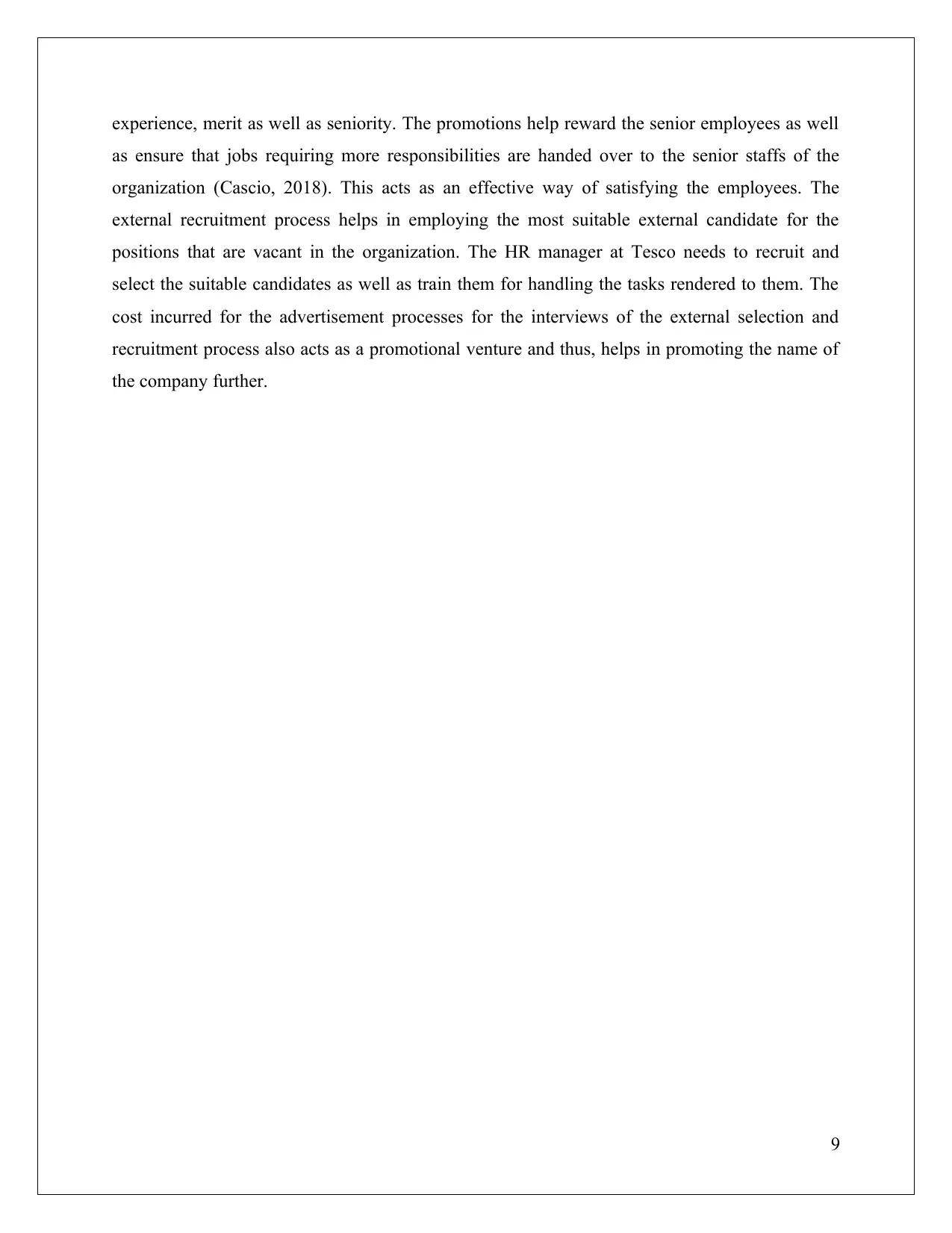
experience, merit as well as seniority. The promotions help reward the senior employees as well
as ensure that jobs requiring more responsibilities are handed over to the senior staffs of the
organization (Cascio, 2018). This acts as an effective way of satisfying the employees. The
external recruitment process helps in employing the most suitable external candidate for the
positions that are vacant in the organization. The HR manager at Tesco needs to recruit and
select the suitable candidates as well as train them for handling the tasks rendered to them. The
cost incurred for the advertisement processes for the interviews of the external selection and
recruitment process also acts as a promotional venture and thus, helps in promoting the name of
the company further.
9
as ensure that jobs requiring more responsibilities are handed over to the senior staffs of the
organization (Cascio, 2018). This acts as an effective way of satisfying the employees. The
external recruitment process helps in employing the most suitable external candidate for the
positions that are vacant in the organization. The HR manager at Tesco needs to recruit and
select the suitable candidates as well as train them for handling the tasks rendered to them. The
cost incurred for the advertisement processes for the interviews of the external selection and
recruitment process also acts as a promotional venture and thus, helps in promoting the name of
the company further.
9
⊘ This is a preview!⊘
Do you want full access?
Subscribe today to unlock all pages.

Trusted by 1+ million students worldwide
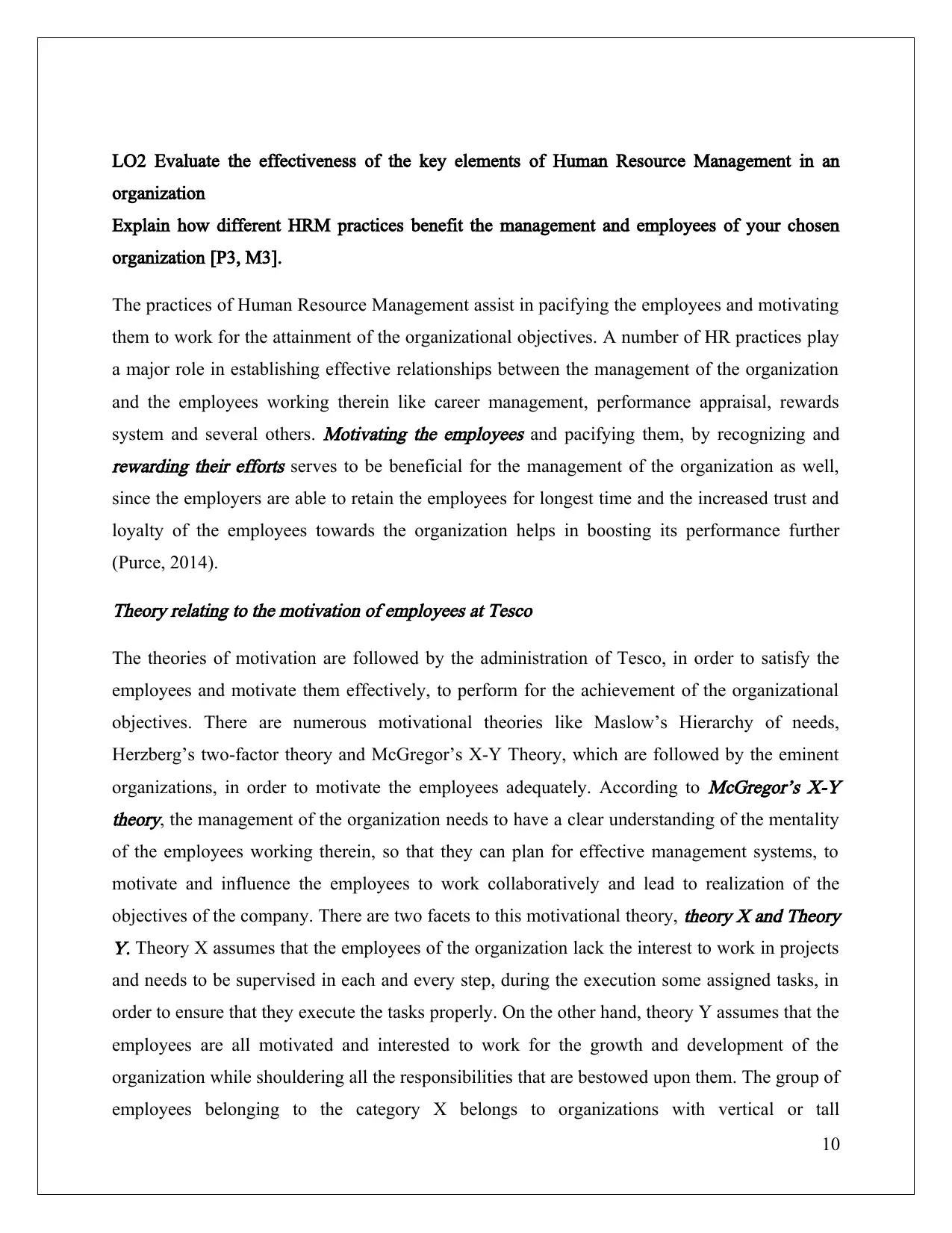
LO2 Evaluate the effectiveness of the key elements of Human Resource Management in an
organization
Explain how different HRM practices benefit the management and employees of your chosen
organization [P3, M3].
The practices of Human Resource Management assist in pacifying the employees and motivating
them to work for the attainment of the organizational objectives. A number of HR practices play
a major role in establishing effective relationships between the management of the organization
and the employees working therein like career management, performance appraisal, rewards
system and several others.
Motivating the employees and pacifying them, by recognizing andrewarding their efforts serves to be beneficial for the management of the organization as well,
since the employers are able to retain the employees for longest time and the increased trust and
loyalty of the employees towards the organization helps in boosting its performance further
(Purce, 2014).
Theory relating to the motivation of employees at Tesco
The theories of motivation are followed by the administration of Tesco, in order to satisfy the
employees and motivate them effectively, to perform for the achievement of the organizational
objectives. There are numerous motivational theories like Maslow’s Hierarchy of needs,
Herzberg’s two-factor theory and McGregor’s X-Y Theory, which are followed by the eminent
organizations, in order to motivate the employees adequately. According to
McGregor’s X-Y
theory, the management of the organization needs to have a clear understanding of the mentality
of the employees working therein, so that they can plan for effective management systems, to
motivate and influence the employees to work collaboratively and lead to realization of the
objectives of the company. There are two facets to this motivational theory,
theory X and Theory
Y. Theory X assumes that the employees of the organization lack the interest to work in projects
and needs to be supervised in each and every step, during the execution some assigned tasks, in
order to ensure that they execute the tasks properly. On the other hand, theory Y assumes that the
employees are all motivated and interested to work for the growth and development of the
organization while shouldering all the responsibilities that are bestowed upon them. The group of
employees belonging to the category X belongs to organizations with vertical or tall
10
organization
Explain how different HRM practices benefit the management and employees of your chosen
organization [P3, M3].
The practices of Human Resource Management assist in pacifying the employees and motivating
them to work for the attainment of the organizational objectives. A number of HR practices play
a major role in establishing effective relationships between the management of the organization
and the employees working therein like career management, performance appraisal, rewards
system and several others.
Motivating the employees and pacifying them, by recognizing andrewarding their efforts serves to be beneficial for the management of the organization as well,
since the employers are able to retain the employees for longest time and the increased trust and
loyalty of the employees towards the organization helps in boosting its performance further
(Purce, 2014).
Theory relating to the motivation of employees at Tesco
The theories of motivation are followed by the administration of Tesco, in order to satisfy the
employees and motivate them effectively, to perform for the achievement of the organizational
objectives. There are numerous motivational theories like Maslow’s Hierarchy of needs,
Herzberg’s two-factor theory and McGregor’s X-Y Theory, which are followed by the eminent
organizations, in order to motivate the employees adequately. According to
McGregor’s X-Y
theory, the management of the organization needs to have a clear understanding of the mentality
of the employees working therein, so that they can plan for effective management systems, to
motivate and influence the employees to work collaboratively and lead to realization of the
objectives of the company. There are two facets to this motivational theory,
theory X and Theory
Y. Theory X assumes that the employees of the organization lack the interest to work in projects
and needs to be supervised in each and every step, during the execution some assigned tasks, in
order to ensure that they execute the tasks properly. On the other hand, theory Y assumes that the
employees are all motivated and interested to work for the growth and development of the
organization while shouldering all the responsibilities that are bestowed upon them. The group of
employees belonging to the category X belongs to organizations with vertical or tall
10
Paraphrase This Document
Need a fresh take? Get an instant paraphrase of this document with our AI Paraphraser
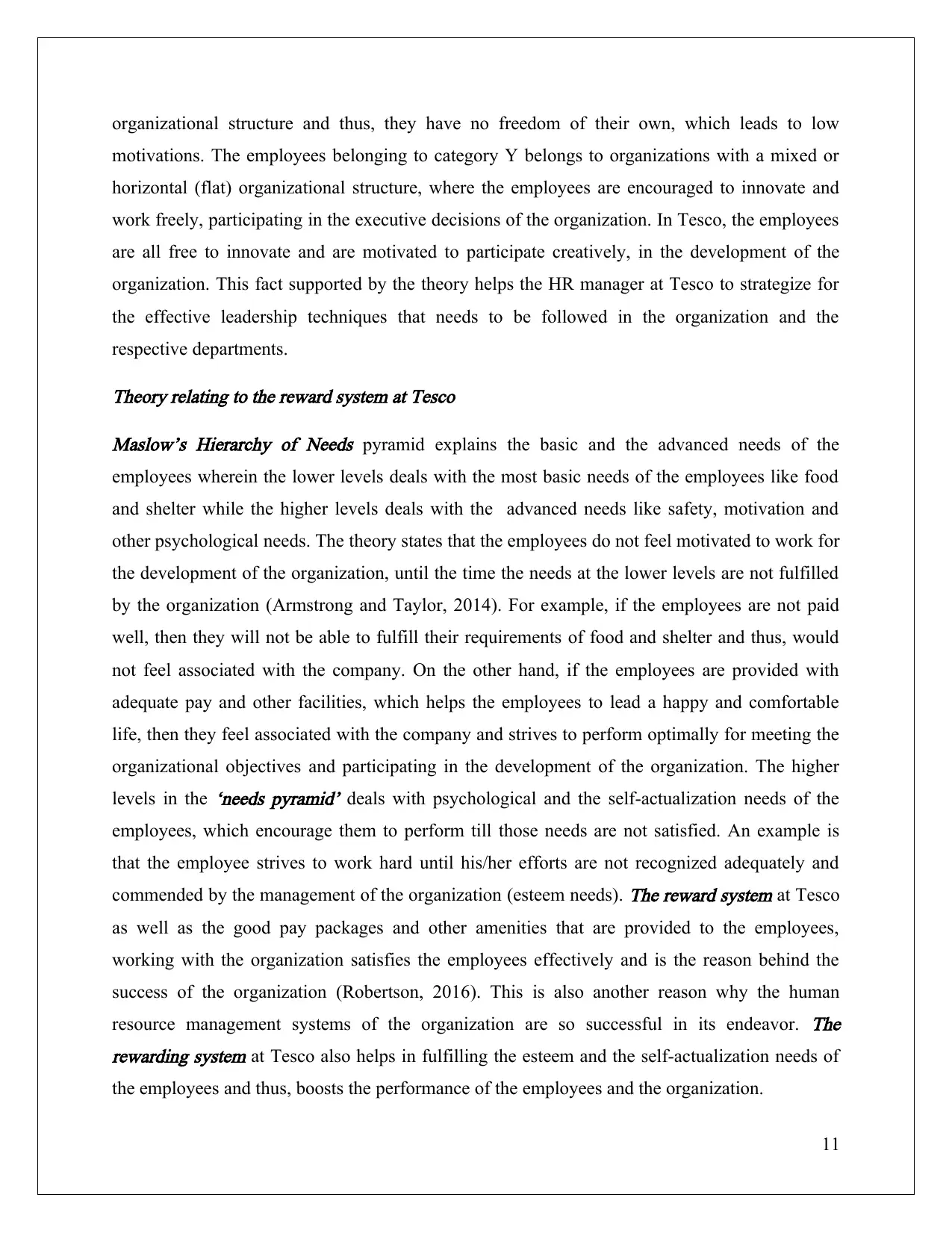
organizational structure and thus, they have no freedom of their own, which leads to low
motivations. The employees belonging to category Y belongs to organizations with a mixed or
horizontal (flat) organizational structure, where the employees are encouraged to innovate and
work freely, participating in the executive decisions of the organization. In Tesco, the employees
are all free to innovate and are motivated to participate creatively, in the development of the
organization. This fact supported by the theory helps the HR manager at Tesco to strategize for
the effective leadership techniques that needs to be followed in the organization and the
respective departments.
Theory relating to the reward system at Tesco
Maslow’s Hierarchy of Needs pyramid explains the basic and the advanced needs of the
employees wherein the lower levels deals with the most basic needs of the employees like food
and shelter while the higher levels deals with the advanced needs like safety, motivation and
other psychological needs. The theory states that the employees do not feel motivated to work for
the development of the organization, until the time the needs at the lower levels are not fulfilled
by the organization (Armstrong and Taylor, 2014). For example, if the employees are not paid
well, then they will not be able to fulfill their requirements of food and shelter and thus, would
not feel associated with the company. On the other hand, if the employees are provided with
adequate pay and other facilities, which helps the employees to lead a happy and comfortable
life, then they feel associated with the company and strives to perform optimally for meeting the
organizational objectives and participating in the development of the organization. The higher
levels in the
‘needs pyramid’ deals with psychological and the self-actualization needs of the
employees, which encourage them to perform till those needs are not satisfied. An example is
that the employee strives to work hard until his/her efforts are not recognized adequately and
commended by the management of the organization (esteem needs).
The reward system at Tesco
as well as the good pay packages and other amenities that are provided to the employees,
working with the organization satisfies the employees effectively and is the reason behind the
success of the organization (Robertson, 2016). This is also another reason why the human
resource management systems of the organization are so successful in its endeavor.
The
rewarding system at Tesco also helps in fulfilling the esteem and the self-actualization needs of
the employees and thus, boosts the performance of the employees and the organization.
11
motivations. The employees belonging to category Y belongs to organizations with a mixed or
horizontal (flat) organizational structure, where the employees are encouraged to innovate and
work freely, participating in the executive decisions of the organization. In Tesco, the employees
are all free to innovate and are motivated to participate creatively, in the development of the
organization. This fact supported by the theory helps the HR manager at Tesco to strategize for
the effective leadership techniques that needs to be followed in the organization and the
respective departments.
Theory relating to the reward system at Tesco
Maslow’s Hierarchy of Needs pyramid explains the basic and the advanced needs of the
employees wherein the lower levels deals with the most basic needs of the employees like food
and shelter while the higher levels deals with the advanced needs like safety, motivation and
other psychological needs. The theory states that the employees do not feel motivated to work for
the development of the organization, until the time the needs at the lower levels are not fulfilled
by the organization (Armstrong and Taylor, 2014). For example, if the employees are not paid
well, then they will not be able to fulfill their requirements of food and shelter and thus, would
not feel associated with the company. On the other hand, if the employees are provided with
adequate pay and other facilities, which helps the employees to lead a happy and comfortable
life, then they feel associated with the company and strives to perform optimally for meeting the
organizational objectives and participating in the development of the organization. The higher
levels in the
‘needs pyramid’ deals with psychological and the self-actualization needs of the
employees, which encourage them to perform till those needs are not satisfied. An example is
that the employee strives to work hard until his/her efforts are not recognized adequately and
commended by the management of the organization (esteem needs).
The reward system at Tesco
as well as the good pay packages and other amenities that are provided to the employees,
working with the organization satisfies the employees effectively and is the reason behind the
success of the organization (Robertson, 2016). This is also another reason why the human
resource management systems of the organization are so successful in its endeavor.
The
rewarding system at Tesco also helps in fulfilling the esteem and the self-actualization needs of
the employees and thus, boosts the performance of the employees and the organization.
11
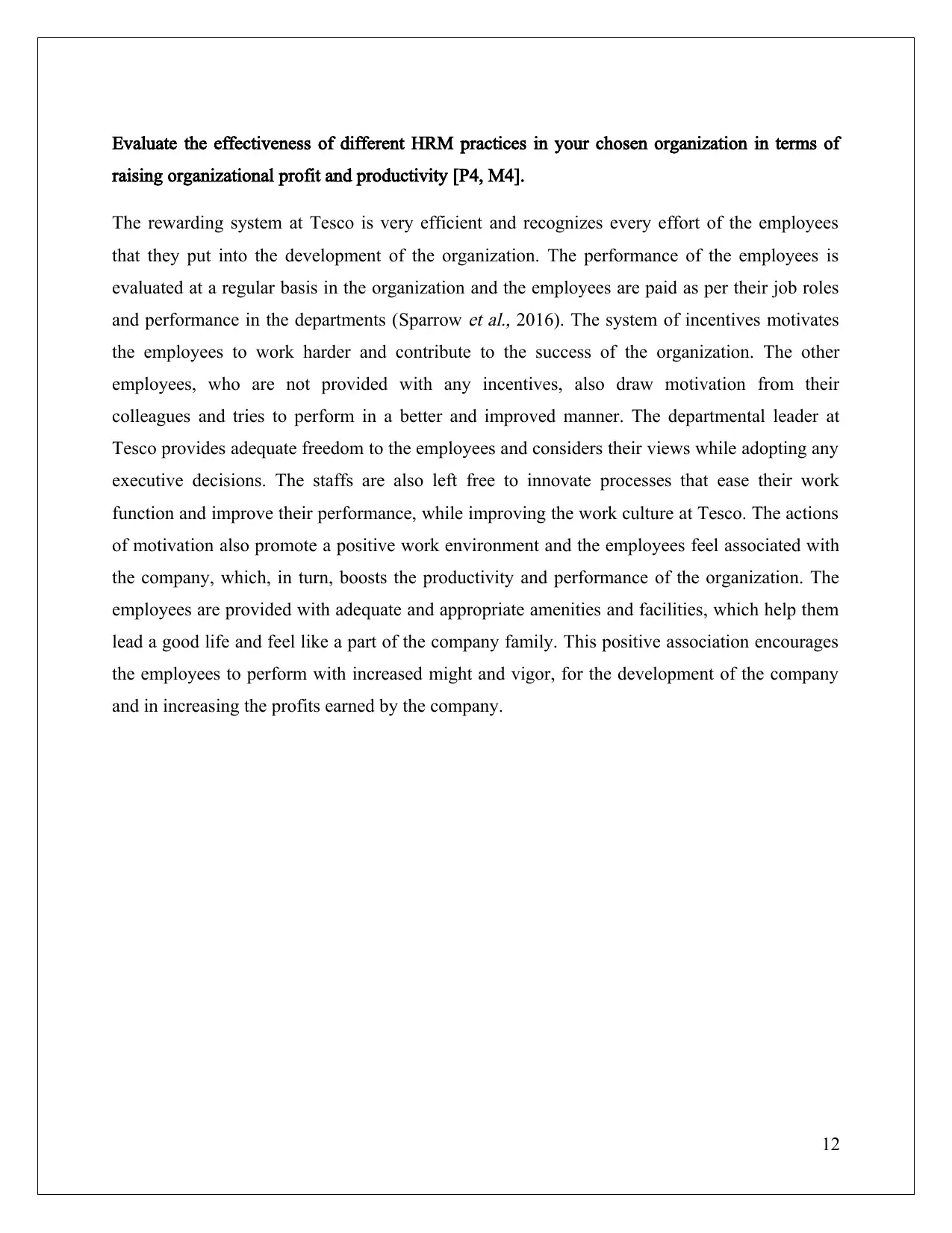
Evaluate the effectiveness of different HRM practices in your chosen organization in terms of
raising organizational profit and productivity [P4, M4].
The rewarding system at Tesco is very efficient and recognizes every effort of the employees
that they put into the development of the organization. The performance of the employees is
evaluated at a regular basis in the organization and the employees are paid as per their job roles
and performance in the departments (Sparrow
et al., 2016). The system of incentives motivates
the employees to work harder and contribute to the success of the organization. The other
employees, who are not provided with any incentives, also draw motivation from their
colleagues and tries to perform in a better and improved manner. The departmental leader at
Tesco provides adequate freedom to the employees and considers their views while adopting any
executive decisions. The staffs are also left free to innovate processes that ease their work
function and improve their performance, while improving the work culture at Tesco. The actions
of motivation also promote a positive work environment and the employees feel associated with
the company, which, in turn, boosts the productivity and performance of the organization. The
employees are provided with adequate and appropriate amenities and facilities, which help them
lead a good life and feel like a part of the company family. This positive association encourages
the employees to perform with increased might and vigor, for the development of the company
and in increasing the profits earned by the company.
12
raising organizational profit and productivity [P4, M4].
The rewarding system at Tesco is very efficient and recognizes every effort of the employees
that they put into the development of the organization. The performance of the employees is
evaluated at a regular basis in the organization and the employees are paid as per their job roles
and performance in the departments (Sparrow
et al., 2016). The system of incentives motivates
the employees to work harder and contribute to the success of the organization. The other
employees, who are not provided with any incentives, also draw motivation from their
colleagues and tries to perform in a better and improved manner. The departmental leader at
Tesco provides adequate freedom to the employees and considers their views while adopting any
executive decisions. The staffs are also left free to innovate processes that ease their work
function and improve their performance, while improving the work culture at Tesco. The actions
of motivation also promote a positive work environment and the employees feel associated with
the company, which, in turn, boosts the productivity and performance of the organization. The
employees are provided with adequate and appropriate amenities and facilities, which help them
lead a good life and feel like a part of the company family. This positive association encourages
the employees to perform with increased might and vigor, for the development of the company
and in increasing the profits earned by the company.
12
⊘ This is a preview!⊘
Do you want full access?
Subscribe today to unlock all pages.

Trusted by 1+ million students worldwide
1 out of 26
Related Documents
Your All-in-One AI-Powered Toolkit for Academic Success.
+13062052269
info@desklib.com
Available 24*7 on WhatsApp / Email
![[object Object]](/_next/static/media/star-bottom.7253800d.svg)
Unlock your academic potential
Copyright © 2020–2025 A2Z Services. All Rights Reserved. Developed and managed by ZUCOL.


